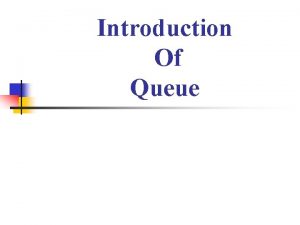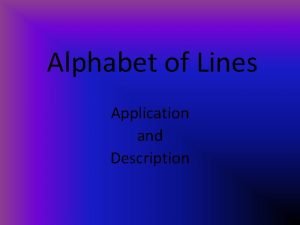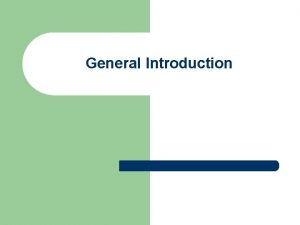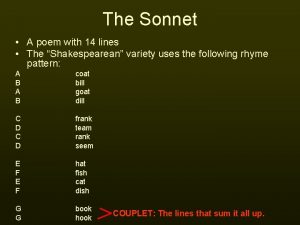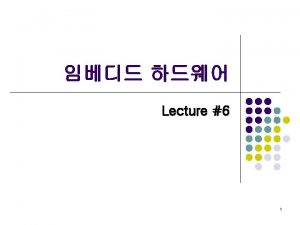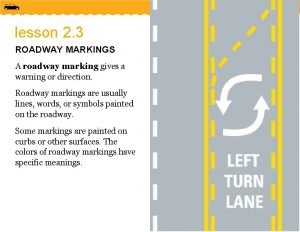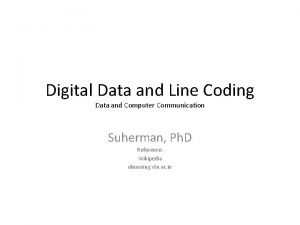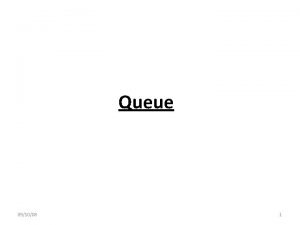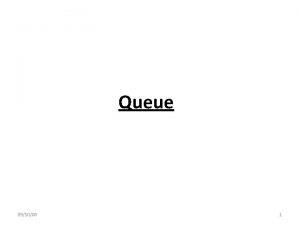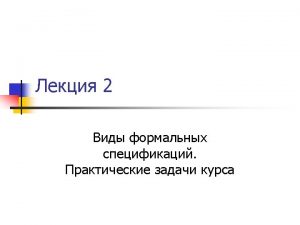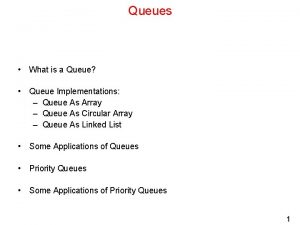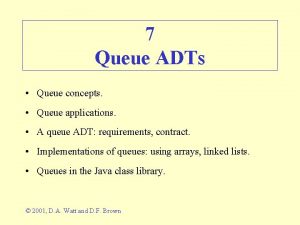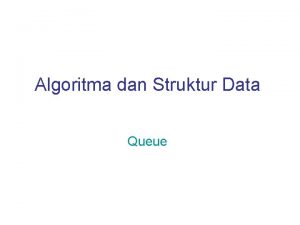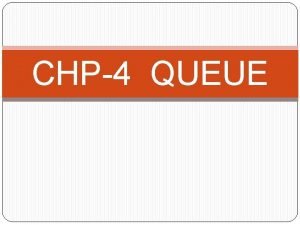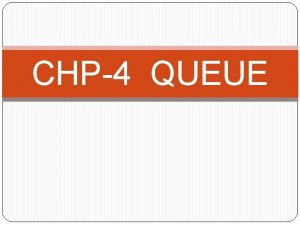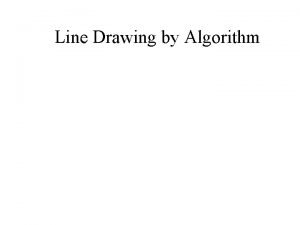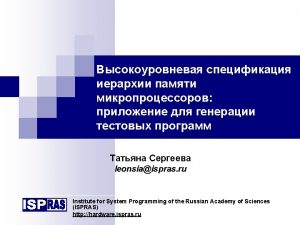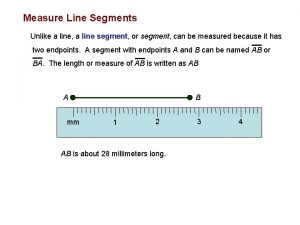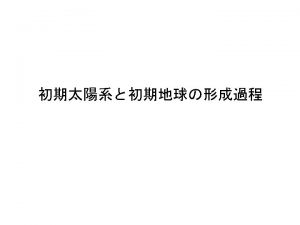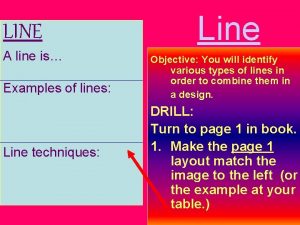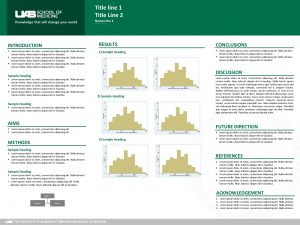Queue Introduction In general Queue is line of







![Create queue C code: struct queue{ int array[SIZE]; int front, rear; }; Create queue: Create queue C code: struct queue{ int array[SIZE]; int front, rear; }; Create queue:](https://slidetodoc.com/presentation_image/27dac454d21eb77772bfe8ad89b3d88f/image-8.jpg)
























- Slides: 32

Queue

Introduction Ø In general, Queue is line of person waiting for their turn at some service counter like ticket window at cinema hall, at bus stand or at railway station etc. The person who come first, he/she gets the service first. Similarly in data structure, Ø Queue is a linear list in which insertions can take place at one end of list, known as rear of the list, and deletions can take place at other end of list, known as front of list. Ø Queue is a ADT as stack except, nature of insertion and deletion of elements. Ø Nature of queue is First Come First Serve (FCFS) or First In First Out (FIFO) Example – Printer task queue, keystroke queue etc.

Representation It can be implemented either using array or using linked list. In both the cases, Queue is defined by its two pointers – 1. FRONT – If queue is empty then FRONT = NULL 2. REAR – If queue is full then REAR = N where, N is the size of array used as queue

Representation (Cont…. ) 5 6 front 4 rear Insert (Enqueue) 15, 4, 9, 6 5 6 4 15 4 9 front 6 rear Delete (Dequeue) 4 times 4 front 9 6 rear

Representation front rear 5 4 6 Insert (Enqueue) 15, 9 front 5 rear 6 4 15 9 Delete (Dequeue) 3 times front rear 15 9

Basic Operations 1. Create. Queue – Creates an empty queue 2. Enqueue – Inserts element into queue 3. Dequeue – Deletes element from queue 4. Is. Empty – Checks the emptiness of queue 5. Is. Full – Checks the fullness of queue

s a y a r r A e u Q r a e n Li
![Create queue C code struct queue int arraySIZE int front rear Create queue Create queue C code: struct queue{ int array[SIZE]; int front, rear; }; Create queue:](https://slidetodoc.com/presentation_image/27dac454d21eb77772bfe8ad89b3d88f/image-8.jpg)
Create queue C code: struct queue{ int array[SIZE]; int front, rear; }; Create queue: Algorithm Create_Queue(Q): This algorithm creates a queue with rear = -1 and front = -1. Here, Q is structure of an {array and front, rear} elements. front and rear represents the first and last item of queue. 1. Q -> front = Q -> rear = -1 // -1 means queue is empty

Enqueue Algorithm Enqueue(Q, Item) – This algorithm inserts an element into queue Q. Item is the element which is to be inserted. 1. If (Q->front == -1 or Q->rear == -1) \ Check for emptiness 2. Q->front = Q->rear = 0 3. Else If ( Q-> rear == SIZE-1) \ Check for fullness 4. If(Q->front == 0) 5. Exit 6. Temp = Q->front 7. While(Temp<= Q->rear) 8. Q->array[Temp – Q->front] = Q->array[Temp] 9. Temp = Temp + 1 10. Q->rear = Q->rear – Q->front + 1 11. Q->front = 0 12. Else 13. Q->rear = Q->rear + 1 14. Q->array[Q->rear] = Item Complexity = O(n)

Dequeue Algorithm Dequeue(Q) – This algorithm deletes an element from queue Q. Item is the element which is returned after deletion. 1. If (Q->front == -1 or Q->rear == -1) \ Check for emptiness 2. Display “Queue is empty” 3. Exit 4. Item = Q->array[Q->front] 5. If ( Q-> rear == Q->front) 6. Q->front = -1 7. Q->rear = -1 8. Else 9. Q->front = Q->front + 1 10. Return Item Complexity = O(1) \ Only one element

Accessing Front Element Algorithm Peep(Q) – This algorithm accesses an element from queue Q. Item is the element which is returned. 1. Item = Q->array[Q->front] 2. Return Item Complexity = O(1)

Limitation of Linear Queue If last position of queue is occupied then it is not possible to enqueue any more elements even though some positions are vacant towards the front end of queue. Solutions: 1. Shift the elements towards beginning of queue or toward left and adjust the front and rear accordingly. But, if linear queue is very long then it would be very time consuming to shift the elements towards vacant positions. 2. Make circular queue

Circular Queue During enqueue of an element in queue, if rear reaches to (SIZE – 1) considering queue starting index is 0 then, Make rear = 0 0 1 2 3 4 4 5 9 6 6 7 14 rear front 4 Creation of circular queue is same as linear queue. 9 6 14 rear

En. Cqueue Algorithm En. Cqueue(CQ, Item) – This algorithm inserts an element into queue CQ. Item is the element which is to be inserted. 1. If (CQ->front == -1 or CQ->rear == -1) 2. CQ->front = CQ->rear = 0 3. Else If ( CQ-> rear == SIZE-1) 4. If(CQ->front == 0) 5. Exit 6. CQ->rear = 0 7. Else If(CQ->rear = = (CQ->front – 1)) 8. Exit 9. Else 10. CQ->rear = CQ->rear + 1 11. CQ->array[CQ->rear] = Item Complexity = O(1) \ Check for emptiness \ Check for fullness

De. Cqueue Algorithm De. Cqueue(CQ) – This algorithm deletes an element from queue CQ. Item is the element which is returned after deletion. 1. If (CQ->front == -1 or CQ->rear == -1) 2. Display “Queue is empty” 3. Exit 4. Item = CQ->array[CQ->front] 5. If ( CQ-> rear == CQ->front) 6. CQ->front = -1 7. CQ->rear = -1 8. Else if (CQ->front == SIZE -1) 9. CQ->front = 0 10. Else 11. CQ->front = CQ->front + 1 12. Return Item Complexity = O(1) \ Check for emptiness \ Only one element

Limitation Ø Size of queue must be known in advance. In real scenario, it is not possible.

s a t s i L d e k e n i u L e u Q r a e n Li

Create queue C code: struct Node{ int INFO; struct Node *NEXT; }; struct Queue{ struct Node *front; struct Node *rear; }Q; Create queue: Algorithm Create_LQueue(Q): This algorithm creates a queue with rear = NULL and front = NULL. Here, Q is a linked list. front and rear the pointers, pointing to first and last item of queue. 1. Q -> front = Q -> rear = NULL // NULL means queue is empty

En. Lqueue Algorithm En. Lqueue(Q, Item) – This algorithm inserts an element into queue Q. Item is the element which is to be inserted. 1. 2. 3. 4. 5. 6. 7. 8. 9. Node Temp = Allocate memory Temp->INFO = Item Temp->NEXT = NULL If (Q->front == NULL or Q->rear == NULL) Q->front = Q->rear = Temp Else (Q->rear)->NEXT = Temp Q->rear = Temp Complexity = O(1) \ Check for emptiness

De. Lqueue Algorithm De. Lqueue(Q) – This algorithm deletes an element from queue Q. Item is the element which is returned after deletion. 1. Node Temp 2. If (Q->front == NULL or Q->rear == NULL) 3. Display “Queue is empty” 4. Exit 5. Item = (Q-> front) ->INFO 6. Temp = Q->front 7. If ( Q-> rear == Q->front) 8. Q->front = NULL 9. Q->rear = NULL 10. Else 11. Q->front = (Q->front)-> NEXT 12. Free Temp 13. Return Item Complexity = O(1) \ Check for emptiness \ Only one element

Deque ( Double-Ended Queue ) Ø Linear queue which allows insertion and deletion from both ends of list Ø Addition or deletion can be performed from front or rear Insertion Deletion 5 6 4 front 15 4 9 6 rear Deletion Insertion There are two variations of deque – 1. Input restricted deque – Insertions from only one end but deletion from both ends 2. Output restricted deque – Insertion from both ends and deletion from one end only

Operations on deque 1. Insertion at beginning – Using front pointer 2. Insertion at end – Using front pointer 3. Deletion at beginning – Using rear pointer 4. Deletion at end – Using rear pointer

Problem Assume that the operators +, -, × are left associative and ^ is right associative. The order of precedence (from highest to lowest) is ^, x , +, -. The postfix expression corresponding to the infix expression a + b × c - d ^ e ^ f is A. abc × + def ^ ^ B. abc × + de ^ f ^ C. ab + c × d - e ^ f ^ D. - + a × bc ^ ^ def Ans: A abc × + def ^ ^ -

Problem Following is C like pseudo code of a function that takes a Queue as an argument, and uses a stack S to do processing. void fun(Queue *Q) { Stack S; // Say it creates an empty stack S while (!is. Empty(Q)) // Run while Q is not empty { // de. Queue an item from Q and push the dequeued item to S push(&S, de. Queue(Q)); } while (!is. Empty(&S)) // Run while Stack S is not empty { // Pop an item from S and enqueue the popped item to Q en. Queue(Q, pop(&S)); } } What does the above function do in general? (A) Removes the last from Q (B) Keeps the Q same as it was before the call (C) Makes Q empty (D) Reverses the Q

Priority Queue Ø A queue where each element is assigned a priority. Ø Lower the number higher the priority. Ø An element with highest priority is processed first before any element of lower priority. Ø If two elements are of same priority then they are processed according to the order in which they were added in queue. Priority decision parameter – 1. Shortest job 2. Payment 3. Time 4. Type of Job etc.

Implementation of priority queue Ø Linear Linked List 6 front Ø 1 8 2 12 3 14 rear 4

Create priority queue C code: struct Node{ int INFO; int priority; struct Node *NEXT; }; struct Queue{ struct Node *front; struct Node *rear; }Q; Create queue: Algorithm Create_PQueue(Q): This algorithm creates a queue with rear = NULL and front = NULL. Here, Q is a linked list. front and rear the pointers, pointing to first and last item of queue. 1. Q -> front = Q -> rear = NULL // NULL means queue is empty

Insertion in priority queue 1. Make node with provided item and assigning priority 2. Insert at proper place according to priority 11 6 front 1 8 2 12 3 3 14 rear 4

Applications of priority queue Ø Very useful in scheduling – - Traffic light - Job scheduling in operating system Ø Bandwidth management – When higher priority customer needs more bandwidth, all other lower priority customer are blocked for some duration. Here, priority may be according to plan which customer use. Ø Huffman coding – To transmit the data efficiently on network.

Summary Ø Overview of Queue – - FIFO - Applications Ø Basic operations on queue – - Enqueue - Dequeue Ø Implementation of queue – - Using array - Using Linked List Ø Types of queue – - Linear Queue - Circular Queue - Deque - Priority Queue

problem The following postfix expression with single digit operands is evaluated using a stack: 8 2 3 ^ / 2 3 * + 5 1 * - Note that ^ is the exponentiation operator. The top two elements of the stack after the first * is evaluated are: (A) 6, 1 (B) 5, 7 (C) 3, 2 (D) 1, 5 Ans: A

problem Following is C like pseudo code of a function that takes a number as an argument, and uses a stack S to do processing. What does the above function do in general? void fun(int n) { Stack S; // Say it creates an empty stack S while (n > 0) { // This line pushes the value of n%2 to stack S push(&S, n%2); n = n/2; } // Run while Stack S is not empty while (!is. Empty(&S)) printf("%d ", pop(&S)); // pop an element from S and print it } What does the above function do in general? (A) Prints binary representation of n in reverse order (B) Prints binary representation of n (C) Prints the value of Logn (D) Prints the value of Logn in reverse order
 Input restricted deque
Input restricted deque Adjustable cross staff in surveying
Adjustable cross staff in surveying Planos en cinematografia
Planos en cinematografia Where did general lee surrender to general grant?
Where did general lee surrender to general grant? Visible lines
Visible lines Introduction to general phonetics and phonology
Introduction to general phonetics and phonology Car insurab
Car insurab General introduction
General introduction Introduction about technology in general
Introduction about technology in general Alfred lord tennyson ulysses analysis
Alfred lord tennyson ulysses analysis To daffodils poem summary
To daffodils poem summary What is thou blind man's mark about
What is thou blind man's mark about Poems with 14 lines
Poems with 14 lines Though emeralds rubies pearls are all
Though emeralds rubies pearls are all Sonnet 60 explanation line by line
Sonnet 60 explanation line by line Rhyme scheme of sonnet 130
Rhyme scheme of sonnet 130 Shakespeare 57 sonnet
Shakespeare 57 sonnet Analyse sonnet 130
Analyse sonnet 130 Word line and bit line
Word line and bit line Act 1 of romeo and juliet in modern english
Act 1 of romeo and juliet in modern english Farewell love and all thy laws forever analysis
Farewell love and all thy laws forever analysis Summary of the poem thunderstorm
Summary of the poem thunderstorm Bertolt brecht the burning of the books
Bertolt brecht the burning of the books Nothing gold can stay paraphrase
Nothing gold can stay paraphrase The poem money madness is written by
The poem money madness is written by Solid yellow line and broken yellow line
Solid yellow line and broken yellow line Apostrophe of the ocean
Apostrophe of the ocean Thou blind man's mark poem
Thou blind man's mark poem Futility summary
Futility summary Out out analysis
Out out analysis Who wrote the poem dreaming black boy
Who wrote the poem dreaming black boy Line coding adalah
Line coding adalah Count that day
Count that day
